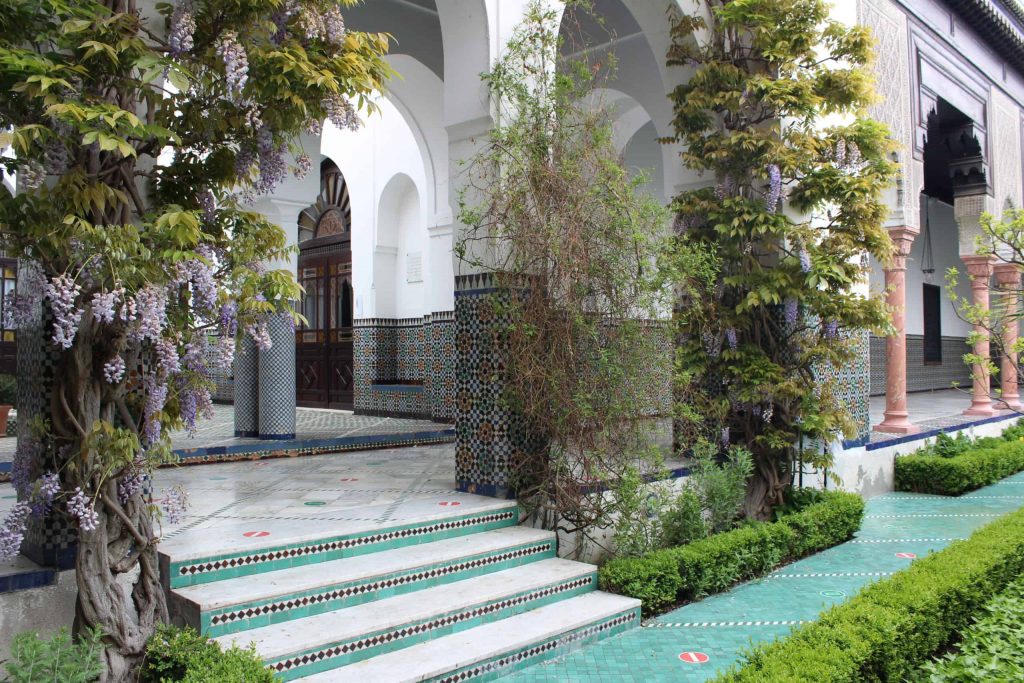This past weekend, I finally visited the Grand Mosque of Paris. I have walked past this building many times in the past, but for one reason or another, I had never taken the time to go inside. However, I recently saw photos online of the mosque’s garden covered in wisteria, and its beauty was breathtaking. Therefore, I decided that I was out of excuses. It was high time for a visit, preferably before the wisteria disappeared for the season. Thankfully, the gardens were just as breathtaking in person as they were in the photos.
But first, a little history. Plans for the construction of a new mosque in Paris were first approved in 1920, and a site was chosen in the 5th arrondissement next to the Jardin des Plantes. The design of the building was modelled after the el-Qaraouyyîn Mosque in Fez, Morocco, one of the oldest mosques in the world, and the 33-meter tall minaret was modelled after the Al-Zaytuna Mosque in Tunisia. The designer was Maurice Tranchant de Lunel, with construction being overseen by Robert Fournez, Maurice Montout and Charles Heubès. However, the founder of the project was Si Kaddour Benghabrit, who later served as the mosque’s first rector.

With the plans approved, the first stones were laid in 1922, and in 1926, the Grand Mosque of Paris was officially inaugurated. It was built to symbolize the friendship between France and Islam, but it also served to commemorate the thousands of Muslims who fought and died for France in World War I. The inauguration was attended by both the French President Gaston Doumergue and Sultan Yusef of Morocco. Three years later, the minbar that is still in use was donated by King Fuad I of Egypt.
Today, the Grand Mosque occupies over 7,500 square metres, including 3,500 square metres of gardens. There is also a prayer room, library, hammam, restaurant, and tea shop, and the mosque is open to visitors every day except Fridays. The gardens tend to be the main draw, especially when they are covered in wisteria, but I found that I couldn’t stop marvelling at the architecture. The building is designed in the Moorish style, and the tile mosaics and carved stucco are extraordinarily beautiful. I kept thinking of the countless hours it must have taken to create them all, and how those hours were absolutely time well spent.

There are several notable stories in the mosque’s history, but my favourite is from World War II and the occupation of Paris. The aforementioned Si Kaddour Benghabrit was still the rector at this time, and he often used the mosque as a shelter for stranded British paratroopers. When the deportation of the Jews in Paris began, Benghabrit began issuing fake passports and certificates of Muslim identity to Jewish families. It is estimated that these actions saved the lives of up to 1,600 Jews, resistance fighters, and other targets of the Nazis. Specifically, it is estimated that at least 500 Jews were saved from deportation because of Benghabrit.

Today, the Grand Mosque of Paris is the largest mosque in France and the third largest in Europe. Perhaps because of its size and prominence, it has sadly been the target of numerous anti-Muslim attacks in recent years. But it has also survived these attacks, and it continues to warmly welcome visitors. The next time you’re in Paris, I highly recommend you pay a visit yourself. The gardens are beautiful, the architecture is stunning, and the tea in the cafe is delicious. They are all well worth a visit.
Laura Moore is a professional storyteller who loves history and the many stories that make Paris one of the most fascinating cities in the world. Join one of her signature tours to learn the story of a city.




